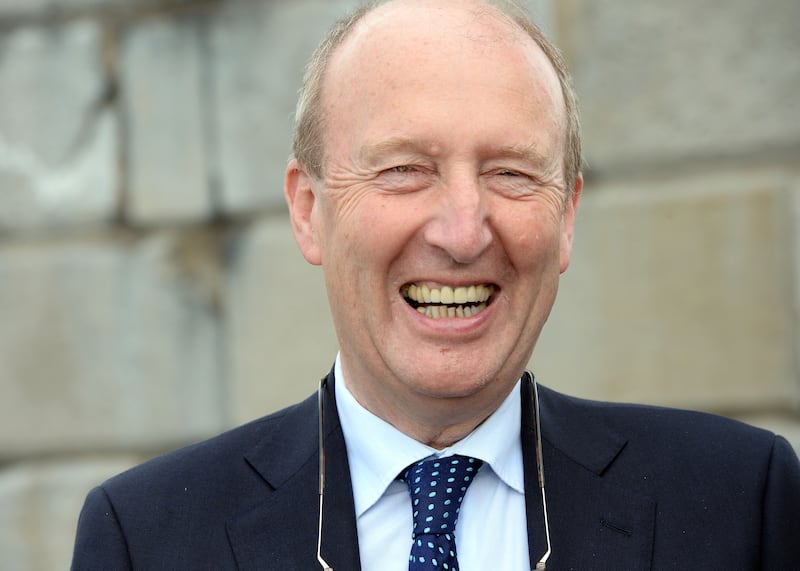Humpty Dumpty was the original spindoctor. “When I choose a word, it means just what I choose it to mean,” he told Alice in Lewis Carroll’s Through the Looking Glass. The irreparable egg spawned a legion of disciples who can be found mostly plying their trade in politics and property. When a government minister’s spokesperson says something is being treated as “a matter of priority” don’t hold your breath. It’s not that they’re lying. It’s just that there is a tailback of priorities. When a house-for-sale advertisement gushes about its “deceptive spaciousness”, it means you may, actually, be able to swing a cat in it but the poor thing will be bashed to death against the encroaching walls.
In his biography of Mary Lou McDonald, entitled A Republican Riddle, Shane Ross repeatedly calls the Sinn Féin leader’s home a “mansion”. He describes the accommodation as incorporating “a dining hall”. According to the former minister for transport, McDonald must explain where she got the money to acquire what was originally a single-storey, one-bedroom cottage and to convert it into two storeys with five bedrooms and “bathrooms to match”. By many of her constituents’ living standards, McDonald’s house certainly looks lovely and large but is it accurate to describe it as a “mansion”?
Shane Ross has not been publicly challenged on the estimates he produced or his description of McDonald’s house. If she needs to answer questions about it, does he not too?
Google the term “Irish mansions” and up pop the likes of Michael Flatley’s three-storey, 18th-century Castlehyde — 12 bedrooms, 10 bathrooms, bar, wine cellar, music room, library, indoor swimming pool — and the late Garech Browne’s Victorian Luggala home with its seven separate lodges and cottages on 5,000 acres. Conversely, remember Jerry Beades of the so-called New Land League ludicrously downplaying Gorse Hill in Killiney, the setting for a bank repossession stand-off replete with tennis court, swimming pool, hot tub, gym and panoramic sea views, as a “bog standard” house. It sold for €9.5 million.
Words are subjective. They cannot be otherwise because we choose them. To readers of Charles Dickens, JK Rowling and The Daily Telegraph, dining halls are vast refectories where Oliver Twist, Harry Potter and Boris Johnson ate their porridge with multitudinous other boys. If McDonald has a “dining hall” in her house, the most pertinent question to be asked is who on earth is she feeding in it?
READ MORE
Ross, who once held an auctioneer’s license, says McDonald and her husband, Martin Lanigan, put their former home on the market in January 2008, asking about €530,000 and sold it privately for a lower price, “probably [in] the region of €485,000″. The author offers no reason why he concludes the couple took a €45,000 drop in the asking price. He states that he obtained estimates from three anonymous “builder/developer sources” as to the cost of the extension which expanded the house to a reported 254sq m in 2010, a time when Ireland was buried under the ash of the economic crash. He got wildly differing answers of €500,000, €600,000 and €900,000. On face value, the figures are debatable. Even in these days of construction hyperinflation, it is possible to build a 100sq m, two-storey house in Dublin from scratch for €500,000. Ross has not been publicly challenged on the estimates he produced or his description of McDonald’s house. If she needs to answer questions about it, does he not too?

In the chapter on the house, called “The Mansion in Cabra”, he refers to the murky acquisition by Charles Haughey of his capacious home, Abbeville, and to Michael Lowry’s house extension, built compliments of businessman Ben Dunne. Lanigan has threatened to sue Ross. Though he is a private citizen, that threat provides another brick in the wall mural of Sinn Féin’s reputation for litigiousness.
With McDonald already suing RTÉ over a radio interview broadcast last February, some rival politicians have darkly warned that, should she become taoiseach, free speech will be an early casualty. Sinn Féin has helped to sow seeds of concern. McDonald previously sued the Irish Examiner, along with her party colleague Pearse Doherty, settling the case for a reported €100,000 between them. She extracted an apology and a reported payment of €30,000 from Declan Breathnach, a former Fianna Fáil TD in Louth, over something he wrote on Twitter. Other past and present Sinn Féin TDs, including Gerry Adams, Matt Carthy, Aengus Ó Snodaigh and Donnchadh Ó Laoghaire, have all issued defamation proceedings. This rush to the law courts has been denounced by Government parties as a sinister pattern with a potential chill effect on the media.
Yet other parties are in no position to preach from the high moral ground. Former Fine Gael ministers Phil Hogan and Alan Shatter have sued news organisations for libel. In 2019, the same party’s Paudie Coffey settled a libel action he took against his local newspaper while he was a senator. Tánaiste Leo Varadkar has indicated he considered suing Village magazine but decided against it on “legal advice”. Albert Reynolds, when he was taoiseach, took his case all the way to the House of Lords in London. These cases are seldom mentioned when Sinn Féin’s readiness to issue writs is being attacked. Nor is it mentioned that, during the 11 unbroken years Fine Gael has been in government, Ireland’s restrictive libel laws have been castigated by the European Commission as a possible obstacle to exposing corruption. Ross was a member of one of those governments.
It is unedifying to read that unnamed TDs are afraid to speak publicly about legal correspondence they have received from Sinn Féin politicians in which they invoke the very laws governments have allowed to potentially hinder rigorous journalism.
Sinn Féin often complains that the party is demonised by the media. In the spirit of Mandy Rice-Davies, they would say that, wouldn’t they? Every party likes to cry foul. Sometimes, though, they have a point. Last St Valentine’s night, following a Clare Byrne Live edition on RTÉ dedicated to scrutinising Sinn Féin’s fitness for office and featuring a predominantly critical panel, McDonald tweeted: “Words fail me. Goodnight @RTE.”
In an ideal world, nobody would ever sue for libel and journalists would never get anything wrong but that world remains a work in progress. If there is reason to be grateful to Sinn Féin, it is that its litigiousness has demonstrated to some politicians who have received their legal missives, how Irish libel laws can gag public debate and the flow of information in the public interest. As TDs who have made non-disclosure settlements cower in the shadows of anonymity, they might take a while to appreciate the courage of editors and publishers who, despite avalanches of legal threats, persevere in pursuing the truth.
Politicians who warn that Sinn Féin in government will clamp down on media freedom are hurlers on the ditch. Like Humpty Dumpty, they prefer to stay sitting on the wall. And we know what happened to him.













